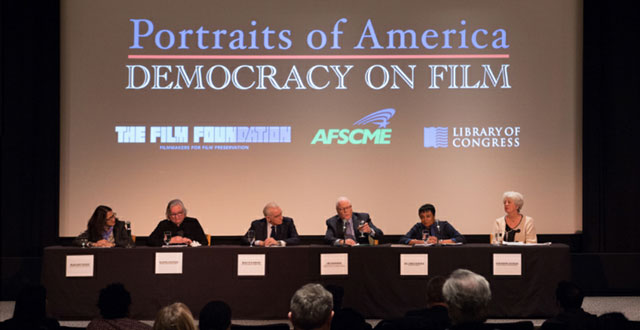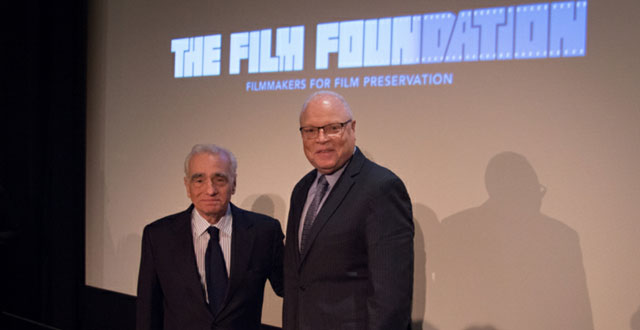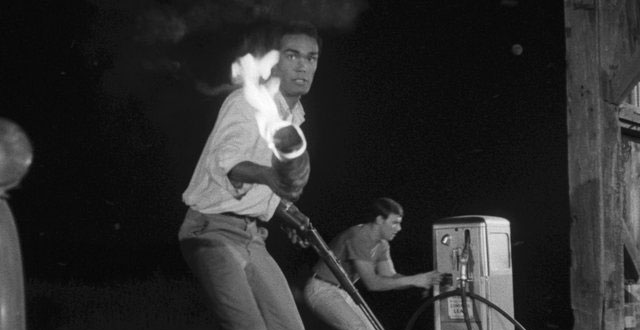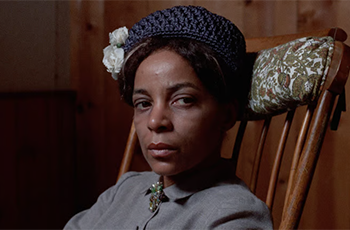News
Martin Scorsese on His Latest Project: Educating Students About The Power of Film
Mara Reinstein
Growing up in a working-class family in the mean streets of New York City’s Little Italy neighborhood, Martin Scorsese admits he didn’t have access to books. He got his education about the world by going to the local cinema.
“I learned a lot about American ideals primarily from the movies,” Scorsese recalls. “Something like The Grapes of Wrath . . . that was an exploitation of labor done in an extraordinary way.”
Now the Oscar-winning director, 75, hopes to pass on the lessons to schools across America. Scorsese was on-hand on a grey afternoon in New York City on Tuesday, March 27 to help announce a new program for The Story of Movies, the first film study program created by filmmakers, film scholars and educators. The curriculum, free of charge, has been used across the U.S. by more than 100,000 teachers in every state since 2000. Explains Scorsese (on a panel with other historians and educators), “It’s absolutely crucial that young people learn how to sort the difference between art and commerce and the difference between a sequence of images that are individually crafted versus images that are mass-produced and used to grab your attention. . . Our hope is that this will inspire teachers and students to go deeper and deeper in engagement with history and politics. There is no difference between verbal and visual literacy.”
The new educational program, titled “Portraits of America: Democracy of Film” explores 38 films from 1917 (Charlie Chaplin’s The Immigrant) to 2006 (the Al Gore documentary, An Inconvenient Truth) that, he says, “expand the history of America and looks squarely at the struggles and violent disagreements and tragedies in our history and its false promises. The films also embody the best of America.” (The program is in conjuction with the American Federation of State, County and Municipal Employees and Scorsese’s Film Foundation.)
The curated curriculum is divided into eight “module” lesson plans, including “The Immigrant Experience,” “The American Laborer,” “Civil Rights,” “The Press” and “Soldiers and Patriots.” Two works from the famed director are on the list — 1993’s The Age of Innocence (“The American Woman”) and 2004’s The Aviator (“The Auteurs”). Each lesson includes a Teacher’s Guide, built-in PowerPoint presentation, reading selections such as reviews and editorial cartoons and supplemental DVD that includes various film clips.
The “Democracy on Film” theme was inevitable: “We’re in a time of division, conflict and anger in our culture.” Noting that he just watched the 1957 paranoia drama The Incredible Shrinking Man one night earlier on Turner Classic Movies, he added, “Movies actually reflect the culture that they come out of. No matter what the intended purpose, fake special effects or bad screen protection, images are records of the moments in time of which they were made.”
And if you want to watch one of the selections on a palm-sized screen, that’s OK too. Sort of. “I first watched Citizen Kane on the Million Dollar Movie on Channel 9! Ultimately, the language itself communicates,” he says. “But is it ideal conditions? Can you still retain that information when a film was made to be seen in a certain way and you needed to make the commitment and sit there for two hours? The idea is to see it in a proper context.”
Film Foundation launches 'Portraits of America' program to teach students visual literacy
Daniel Eagan
At a time when moving images dominate our lives, the idea of "visual literacy," the ability to read and understand images, has taken on a greater urgency. That's one of the impulses behind “Portraits of America: Democracy on Film,” a new program from The Film Foundation, in partnership with the American Federation of State, County and Municipal Employees (AFSCME).
Offered free of charge to elementary and high schools, “Democracy on Film” is made up of eight modules addressing different aspects of the democratic experience, including immigration, labor, civil rights and the press. Within each module, scholars, educators and filmmakers examine movies that reflect American democratic ideals.
The titles extend from 1917 to 2006, and include comedies, documentaries, drama, science fiction, horror, cartoons, historical fiction, independent films and Hollywood blockbusters. Accompanying the curriculum are a teacher's guide, a reader for students, PowerPoint presentations, and a DVD (which can also be streamed) that includes film excerpts and additional material.
Speaking on a panel at New York City's DGA Theater, award-winning director and Film Foundation founder Martin Scorsese noted, "We already teach our students to be critical thinkers, now we have to start teaching them to be critical viewers as well."
For Scorsese, it's crucial that young people "learn to sort the differences between art and pure commerce, between cinema and 'content,' between a sequence of individually crafted images and a sequence of factory-manufactured, mass-produced images engineered only to grab your attention and sell you something."
Other panelists included Librarian of Congress Dr. Carla Hayden; author, professor and film historian Jeanine Basinger; curriculum author Catherine Gourley; and Lee Saunders, president of AFSCME.
"This is an opportunity for my union to put forth the importance of labor history, in the context of American democracy," Saunders said. "Whether it's women's marches or civil-rights marches, things of that nature, struggle has always been a part of our history. We've got to understand that struggle, make that connection with young people so they understand their history. Improving our democracy is a duty we all share."
According to Basinger, "We are living in a world of moving images. Outside the classroom, the moving image is the major form of communication for these young people, a major source of their learning about what's going on in the world, a major source of the way the world speaks to them. It's also the way they communicate with each other.
"The young people of America are simply not educated if they cannot understand how to see moving images, how to interpret them, how to unlock their subtexts and messages, how to read them for an understanding of the country they live, warts and all."
Gourley, the author of more than 30 books, began working on the“Story of Movies” program in 2005. For her, one of the primary goals of “Democracy on Film” is to teach students "how to read a film on multiple levels. Most obviously, what is the story about, what is its narrative structure, what does it mean? But also how to read a film as a work of art. Equally important is learning to read a film as a historical and cultural document."
Dr. Hayden noted that the curriculum will be added to the “Teaching with Primary Sources” curriculum, which focuses on showing teachers and students how to work with original documents. Through the extensive holdings of the Library of Congress, Hayden and her staff were able to supplement film titles with contemporary reviews, political cartoons and interviews that help explain their times.
These materials will be especially useful with some of the titles in the program, like Salt of the Earth, a 1954 independent film about a strike in New Mexico.
"Whatever you may think of the film, Salt of the Earth is a really interesting example of making a picture outside the system," Scorsese said. "They made that film with no help at all because they needed to. What is it all about? It's about human dignity, freedom. This is what we have to fight for."
"One of the things we tried to do with a film like Salt of the Earth is provide primary source materials that explore the tenor of the time," Gourley added. "How people reacted to it at the time. Salt of the Earth was condemned on the floor of Congress, so we include that speech from that congressman, and we allow the students to read it and ask them, what do you think?"
"It's humanizing issues to make you think further than just slogans, and make you aware of things in your own life that you maybe haven't thought about," Basinger agreed. "And with a film like The Immigrant [made by Charlie Chaplin in 1917], there's no great political leveler like humor."
Salt of the Earthis one of five titles in a module on "The American Laborer." Others include Barbara Kopple's Harlan County U.S.A. (1976), about a coal strike in Kentucky, and Martin Ritt's Oscar-winning union drama Norma Rae (1979).
"I learned a lot about unions," Scorsese recalled. "My parents worked in the garment district, my mother was a seamstress. This was before the unions, the sign was: 'You don't come in Sunday, don't come in Monday.' That's not even about hardship, about treatment. Somebody's got to get organized. Then you go from there. A film I'm making now [The Irishman], one of the characters is Jimmy Hoffa. Whatever may have happened in the Hoffa story, he was still on those picket lines getting his head busted."
The next program from the Film Foundation's “Story of Movies” will cover one of the country's enduring themes: “The American West and the Western Film Genre.” It will be released later this year.
"Division, conflict and anger seem to be defining this moment in culture," Scorsese summed up. "I learned a lot about citizenship and American ideals from the movies I saw. Movies that look squarely at the struggles, violent disagreements and the tragedies in history, not to mention hypocrisies, false promises. But they also embody the best in America, our great hopes and ideals."
Martin Scorsese’s New Film Course: ‘Portraits of America’ Teaches Democracy Through Chaplin, Coppola, and More
Zack Sharf
"We have to teach our students to be critical viewers," Scorsese said during a press conference announcing the new film curriculum.
Martin Scorsese and his nonprofit organization The Film Foundation have announced their brand-new film curriculum, “Portraits of America: Democracy on Film.” The curriculum is the latest addition to the group’s ongoing film course “The Story of Movies,” which aims to teach students how to read the language of film and place motion pictures in the context of history, art, and society. Both “Democracy on Film” and the course are completely free for schools and universities.
“Portraits of America: Democracy on Film” is broken down into eight different sections, all of which include in-depth looks at some of the most important American films ever made, from Chaplin to Ford, Coppola, Spielberg, and ultimately Scorsese himself. The program is presented in partnership with AFSCME. Scorsese announced the curriculum at a March 27 press conference in New York City.
Per Scorsese, the “Portraits of America” course features eight modules, and within each are four to five chapters focusing on specific films for in-depth study. “The American Woman” module, for instance, suggests Ridley Scott’s “Alien” for conversation, while “The Immigrant Experience” includes” The Godfather.”
An outline of the latest curriculum is below. Visit “The Story of Movies” official website for more information.
Module 1: The Immigrant Experience
Introductory Lesson: From Penny Claptrap to Movie Palaces—the First Three Decades
Chapter 1: “The Immigrant” (1917, d. Charlie Chaplin)
Chapter 2: “The Godfather, Part II” (1974, d. Francis Ford Coppola)
Chapter 3: “America, America” (1963, d. Elia Kazan)
Chapter 4: “El Norte” (1983, d. Gregory Nava)
Chapter 5: “The Namesake” (2006, d. Mira Nair)
Module 2: The American Laborer
Introductory Lesson: The Common Good
Chapter 1: “Black Fury” (1935, d. Michael Curtiz)
Chapter 2: “Harlan County U.S.A.” (1976, d. Barbara Kopple)
Chapter 3: “At the River I Stand” (1993, d. David Appleby, Allison Graham and Steven Ross)
Chapter 4: “Salt of the Earth” (1954, d. Herbert J. Biberman)
Chapter 5: “Norma Rae” (1979, d. Martin Ritt)
Module 3: Civil Rights
Introductory Lesson: The Camera as Witness
Chapter 1: King: A Filmed Record…Montgomery to Memphis (1970, conceived & created by
Ely Landau; guest appearances filmed by Sidney Lumet and Joseph L.
Mankiewicz)
Chapter 2: “Intruder in the Dust” (1949, d. Clarence Brown)
Chapter 3: “The Times of Harvey Milk” (1984, d. Robert Epstein)
Chapter 4: “Smoke Signals” (1998, d. Chris Eyre)
Module 4: The American Woman
Introductory Lesson: Waysof Seeing Women
Chapter 1: Through a Woman’s Lens: Directors Lois Weber (focusing on “Suspense,” 1913 and
“Where Are My Children,” 1916) and Dorothy Arzner (“Dance, Girl, Dance,” 1940)
Chapter 2: “Imitation of Life” (1934, d. John M. Stahl)
Chapter 3: “Woman of the Year” (1942, d. George Stevens)
Chapter 4: “Alien” (1979, d. Ridley Scott)
Chapter 5: “The Age of Innocence” (1993, d. Martin Scorsese)
Module 5: Politicians and Demagogues
Introductory Lesson: Checks and Balances
Chapter 1: “Gabriel Over the White House” (1933, d. Gregory La Cava)
Chapter 2: “A Lion is in the Streets” (1953, d. Raoul Walsh)
Chapter 3: “Advise and Consent” (1962, d. Otto Preminger)
Chapter 4: “A Face in the Crowd” (1957, d. Elia Kazan)
Module 6: Soldiers and Patriots
Introductory Lesson: Movies and Homefront Morale
Chapter 1: “Sergeant York (1941, d. Howard Hawks)
Chapter 2: Private Snafu’s Private War—three Snafu Shorts from WWII
Chapter 3: “Three Came Home” (1950, d. Jean Negulesco)
Chapter 4: “Glory” (1989, Edward Zwick)
Chapter 5: “Saving Private Ryan” (1998, d. Steven Spielberg)
Module 7: The Press
Introductory Lesson: Degrees of Truth
Chapter 1: “Meet John Doe” (1941, d. Frank Capra)
Chapter 2: “All the President’s Men” (1976, d. Alan J. Pakula)
Chapter 3: “Good Night, and Good Luck” (2005, d. George Clooney)
Chapter 4: “An Inconvenient Truth” (2006, d. Davis Guggenheim)
Chapter 5: “Ace in the Hole” (1951, d. Billy Wilder)
Module 8: The Auteurs
Introductory Lesson: Film as an Art Form
Chapter 1: “Modern Times” (1936, Charlie Chaplin)
Chapter 2: “The Grapes of Wrath”(1940, d. John Ford)
Chapter 3: “Citizen Kane” (1941, d. Orson Welles)
Chapter 4: “An American in Paris” (1951, d. Vincente Minnelli)
Chapter 5: “The Aviator” (2004, d. Martin Scorsese)
Additional reporting by Eric Kohn.
‘Night of the Living Dead’: Zombies Restored to Their Full Beauty
Glenn Kenny
On Feb. 13, just in time for Valentine’s Day, the Criterion Channel on FilmStruck debuted “Night of the Living Dead,” George A. Romero’s 1968 horror classic. The posting is notable for several reasons.
For one thing, if you stream a lot of video, you know that “Night of the Living Dead” is everywhere. There are three versions, including a colorized one, free to Amazon Prime members. So you may well ask why the FilmStruck/Criterion Channel offering is a big deal. It’s because the version appearing on the site is a new restoration from the film’s original negative, produced by the Film Foundation (the preservation nonprofit founded by the director Martin Scorsese) and the Museum of Modern Art, which put “Night of the Living Dead” in its permanent collection. The restored film was shown in November 2016 at MoMA and later in repertory and art house theaters all over the country.
For another, this is the second time Criterion has put up a film on the site the same day as its release on physical media, in this case a two-disc Blu-ray on the Criterion Collection label. (The first time this happened was with “Desert Hearts,” released and posted last November.)
Some skeptics online who haven’t seen the restoration ask “how good can the new version look?” After all, “Living Dead” is one of the original low-budget horror movies that morphed into a classic. The answer lies in part with just how bad the versions you can watch on Amazon Prime look. There’s one with a “Fisher Klingenstein Films” logo before the opening shot. The image is blurry, with the whites far too bright, washed-out and lacking in detail. A “50th Anniversary” edition, touting the movie as “Now Available in 1080p High-Definition-2K HD transfer from a rare film print” may well be as advertised. Yet however “rare” the print from which the version was scanned, it wasn’t in very good shape. A lot of scratches and blotches, and overly high contrasts that deepen the blacks into nothingness while distorting the whites. We shall not even speak of the colorized version.
These various iterations exist because the movie’s original distributor failed to copyright it. Once it went into the public domain, anyone with a print of the movie could distribute it anywhere, produce video versions, and more, free. The creators of the movie didn’t make any money. The Film Foundation and MoMA allowed Image Ten, the original company behind the film, founded by the director, Mr. Romero, the producing brothers Gary and Russell Streiner, and the writer John Russo, among others, to register a copyright for this restoration. And Janus Films and its sister company Criterion licensed the movie from Image Ten. So this is the only edition of the film that yields revenue to all its original creators.
And it does, in fact, look amazing. “Night of the Living Dead” broke new horror ground with its story of a group of strangers trying to work together to fend off a mysterious attack by risen corpses determined to feast on the living. Its influence is felt on just about every zombie movie since. Yes, it was a low-budget picture, but it was made by artists who knew what they were doing.
The restoration doesn’t make the movie look slick, but it gets the true, sharp contrasts of the cinematography. This imbues much of the movie with what was then recognized as a documentary-style realism, which bolsters the emotional power of the tale. When I interviewed Mr. Romero about the restoration, he said, with affection in his voice: “The movie’s pimples do show. There’s a copy of the script visible in one of the frames! I won’t tell where. It will be a little challenge for the fans to spot it.”
On a recent viewing of the restoration, I was able to spot it — although for a while I didn’t think I would, so engrossed was I, even after probably dozens of viewings. I won’t reveal its exact whereabouts, except to say it’s after the movie’s 75-minute mark.
And the FilmStruck/Criterion Channel presentation also offers some supplements that are on the Blu-ray package. There’s a nearly half-hour video featuring the filmmakers Frank Darabont, Guillermo del Toro and Robert Rodriguez,
expounding on the movie’s influence. You can also watch “Night of Anubis,” a 16-millimeter “work print” of “Living Dead” under a different title. It’s raggedy looking and only minimally different in content to the finished film, but it’s of interest to fans who want to peer into the filmmakers’ process; Russell Streiner, one of the film’s producers, who also plays the memorable role of Johnny, who has the car keys, gives a thorough introduction to the supplement.
So yes — the FilmStruck/Criterion Channel “Night of the Living Dead” is the one to see. And it is, in the parlance of Criterion, “director approved” — Mr. Romero, who died in July 2017, did sign off on this version. You will not be disappointed to see the movie as he intended.
A version of this article appears in print on February 18, 2018, on Page AR14 of the New York edition with the headline: George Romero’s Vintage Zombies Are Resurrected.




